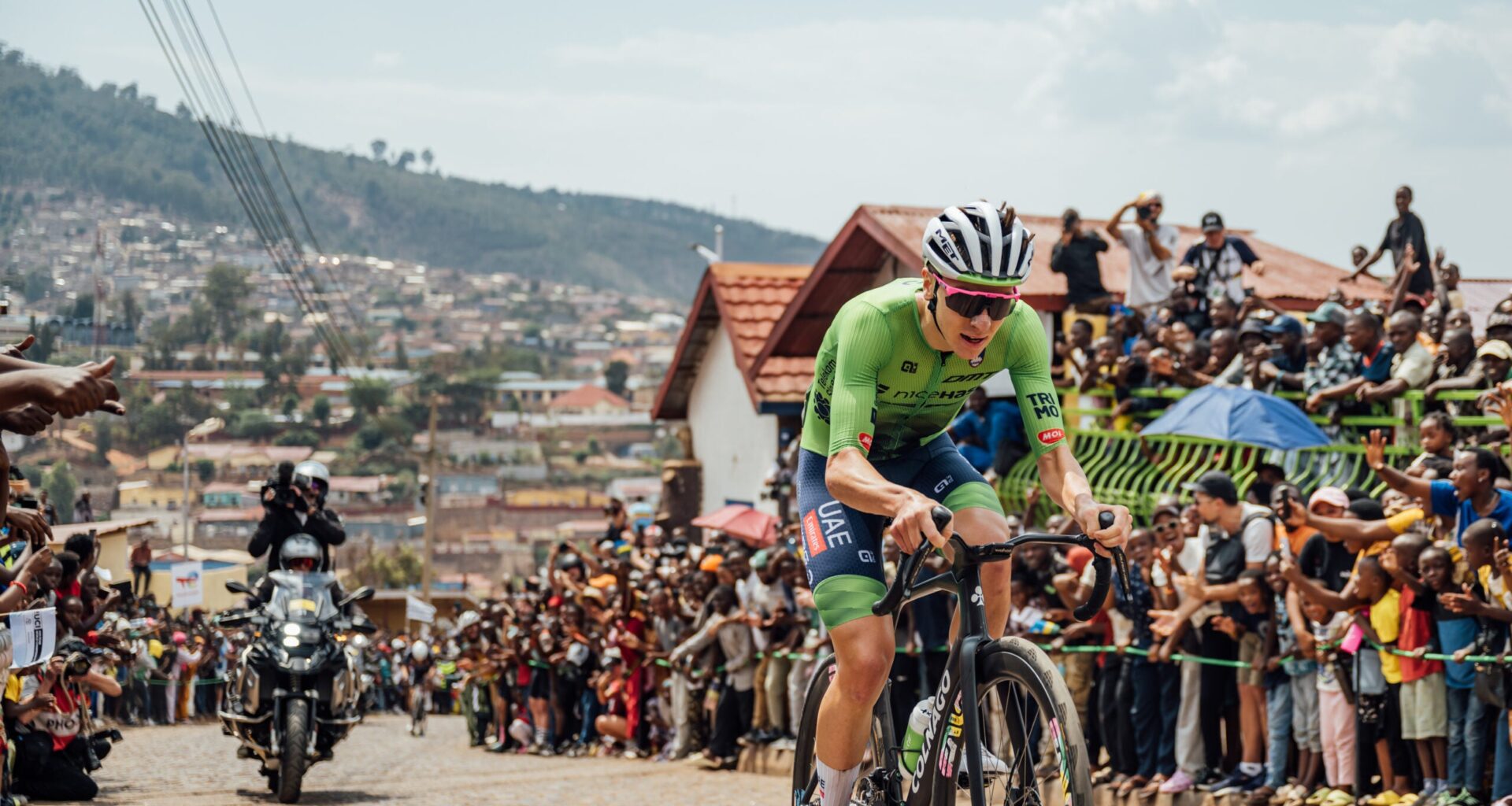Pogačar won his second rainbow jersey with a single sledgehammer acceleration and an impeccably paced solo. Here are the numbers behind the obliteration.
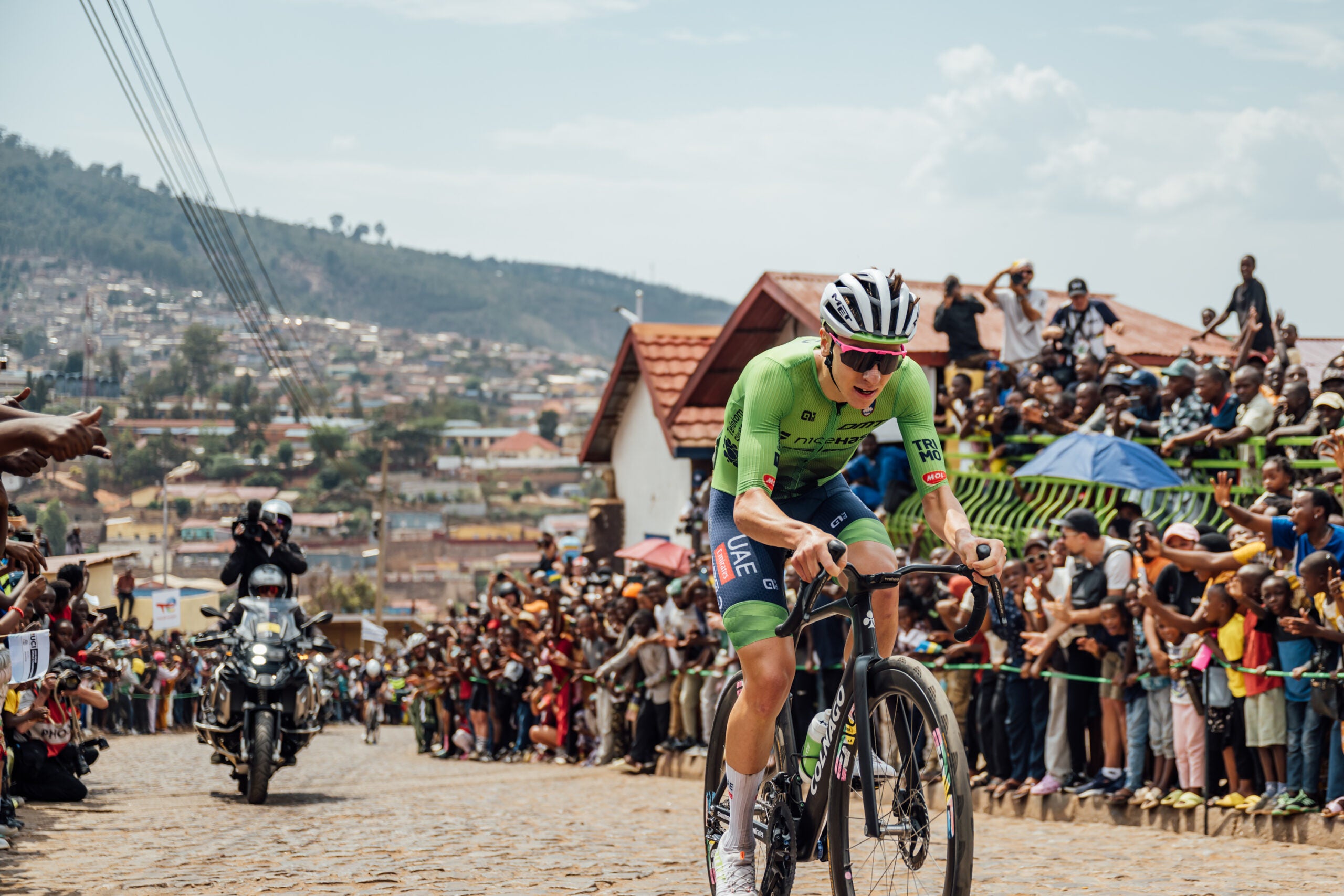
(Photo: Chris Auld)
Published September 30, 2025 02:45AM
A 100km attack is absolutely ridiculous. No one in their right mind could ever think of trying that … until Tadej Pogačar did exactly that in last year’s road world championships.
The Slovenian won his first rainbow jersey by attacking with 101km on that hilly route in Zürich, and he basically did the same in this year’s road race in Rwanda.
It was billed to be the hardest road world championships ever at 267.5km long with over 5,000 meters of climbing. Mont Kigali was the hardest climb on course, but it topped out more than 104km from the finish.
If Pogačar went there, it would be far too early, right?
The other teams would organize a chase, and Pogačar would lose time on the fast city circuits. There were 15 local circuits to be done, with six of them coming after Mont Kigali. There were two small climbs each lap, the Côte de Kigali Golf (0.8km at 8.1%) and the cobblestone Côte de Kimihurura (1.3km at 6.3%). The rest of the lap was made up of fast and rolling city roads – wide highways and high-speed corners that would make it difficult for a breakaway to survive.
But as we watched race after race on the Rwanda world’s course – Juniors, U23, and Elite Women – we saw more and more solo winners. They were all races of attrition where only the strong survived.
It was a parcours perfect for Pogačar.
His attack was inevitable and obvious. But could anyone do anything about it?
The inevitable attack: 8.6w/kg for three minutes … at altitude
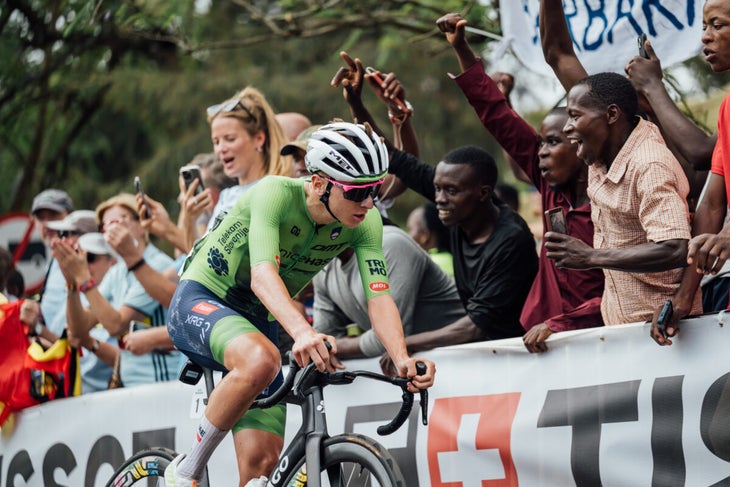 Pogačar’s attack felt inevitable. And when it came, it was unstoppable. (Photo: Chris Auld)
Pogačar’s attack felt inevitable. And when it came, it was unstoppable. (Photo: Chris Auld)
In the beginning, there were two riders that could follow Pogačar: Juan Ayuso and Isaac Del Toro.
After 150km of racing, the peloton came screaming towards the foot of Mont Kigali, a 5.9km climb with an average of 6.9%. But those stats don’t tell the whole story. Mont Kigali is a stair-step climb, characterized by three steep pitches separated by two flat sections. So the average gradient of 6.9% is deceiving – when the road was going uphill, the actual gradients were more like 10-14%.
The final kilometer of Mont Kigali is the steepest at an average of 13%. Even the fastest climbers in the world would struggle to hold 15kph on these slopes.
It was the perfect launchpad for Pogačar, and that’s exactly where he went.
Pre-race favorites like Remco Evenepoel, Tom Pidcock, and Ben Healy were put on a gap immediately. Richard Carapaz tried and failed to get across, while Isaac Del Toro put himself on a manageable gap. The only rider who could stay on Pogačar’s wheel was Juan Ayuso.
After nearly four hours of racing, each rider had already burned between 3,500 and 4,500 kJs before Mont Kigali.
Pogačar’s trade teammate, Pavel Sivakov, was one of the riders closest to the Slovenian throughout the race. The Frenchman had a normalized power of 327w coming into the base of Mont Kigali, and by the top of the climb, he was already 28 seconds behind Pogačar.
Sivakov did 504w (7.3w/kg) for the final 900 meters of Mont Kigali, and Pogačar was 15% faster.
This was an attack similar to the Slovenian’s record-breaking ascent of the Côte de La Redoute, the four-minute climb that defines the finale of Liège–Bastogne–Liège. Pogačar did just over 2,220 Vm/h on the Côte de La Redoute this year, but his final ascent of Mont Kigali was even more impressive at 2,330 Vm/h for three minutes.
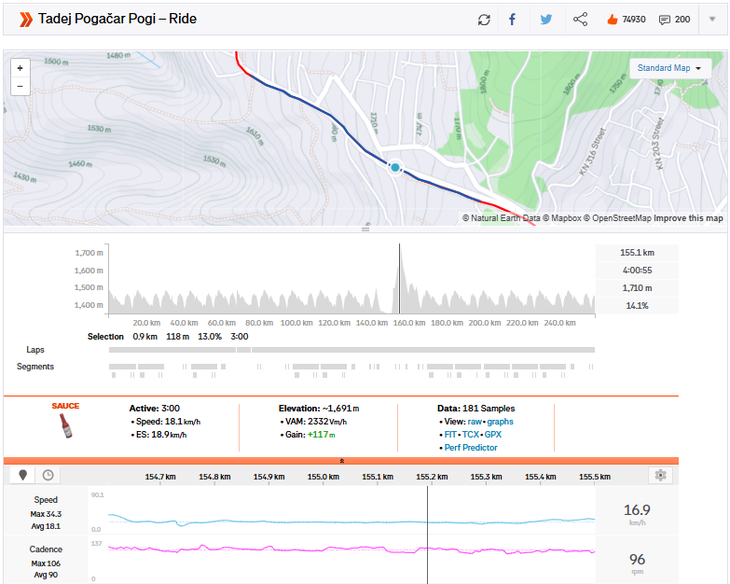
Pogačar – Final 900m of Mont Kigali
Time: 3:00
Estimated Power: 554w (8.6w/kg)
VAM: 2,332 Vm/h
Sivakov: 504w (7.3w/kg) for 3:28
Del Toro bridged across to Pogačar and Ayuso on the Mont Kigali descent, and it was only a few kilometers until they began the Mur de Kigali.
Dropping Del Toro
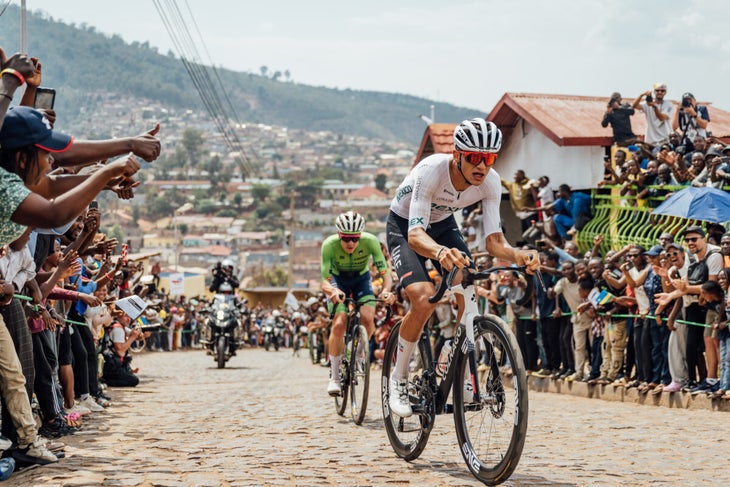 Del Toro couldn’t hang with Pogi for long. (Photo: Chris Auld)
Del Toro couldn’t hang with Pogi for long. (Photo: Chris Auld)
At just 400m with a maximum gradient of 15%, the Mur de Kigali is a cobblestone climb comparable to the Koppenberg in Flanders. It took the strongest riders in the world just over a minute to climb, and it required a seated, high-powered effort from the bottom.
The Mexican attacked at the bottom of the Mur, riding full gas with Pogačar a few bike lengths behind. Ayuso began to flounder, and by the top of the climb, the Spaniard was already 10 seconds behind. After riding full gas on Mont Kigali, Pogačar and Del Toro did an all-out 1-min effort on the Mur de Kigali.
According to Strava, they went faster than every other rider in the peloton, despite having attacked just a few kilometers prior.
Not only is this 1-min effort impressive on its own, but you have to remember that Pogačar and Del Toro went straight into a two-man rotation after the climb.
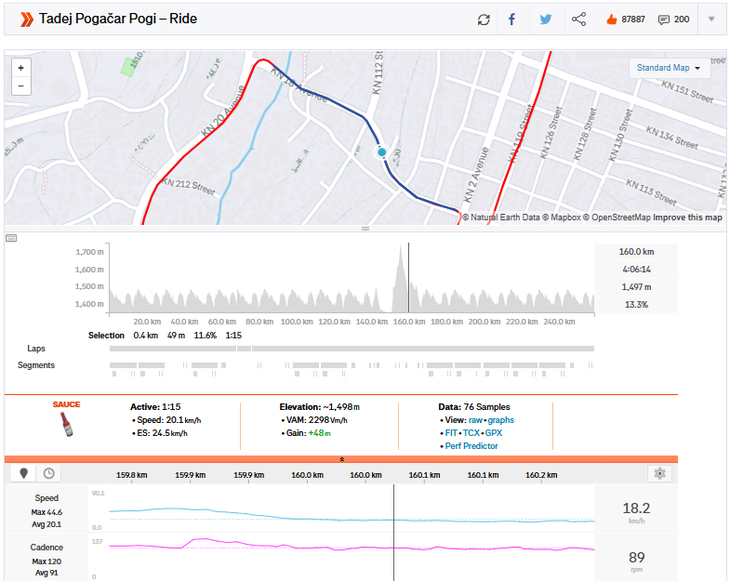
Pogačar – Mur de Kigali
Time: 1:15
Estimated Power: 650w (10.2w/kg)
Pogačar and Del Toro continued working together for the next 30km, increasing their gap over the chasers to nearly a minute.
Pidcock, Healy, and Ayuso were part of that main group of chasers, while Evenepoel was a further 30 seconds behind due to multiple bike changes. The Belgian eventually made his way back to the chase group, pulling hard and surging on each climb.
With 67km to go, the pace caught up with Del Toro, and the Mexican fell back to the chase group while Pogačar continued solo. In this final portion of the race, Pogačar never had a lead of more than 90 seconds. But he kept pushing, even as some chasers began attacking behind.
Pogačar’s perfectly-paced rainbow solo
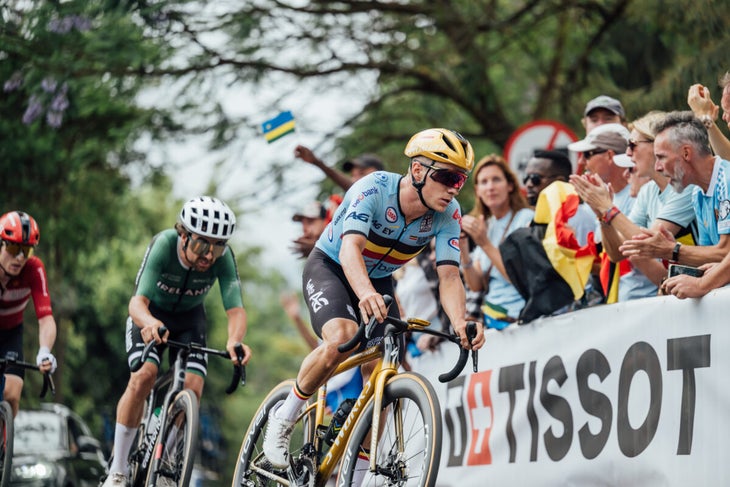 Not even the big engines of Evenepoel and Healy could close down Pogačar. (Photo: Chris Auld)
Not even the big engines of Evenepoel and Healy could close down Pogačar. (Photo: Chris Auld)
Healy, Skjelmose, and Evenepoel formed the main chase group on the road while Pogačar continued solo. Lap after lap, Pogačar maintained his pace up and over the Côte de Kigali Golf and the Côte de Kimihurura.
Using Pogačar’s Strava file, we can estimate his wattage each time he ascended these climbs. More on that in a minute.
His lap times were not only consistent, but he was actually going faster in the second half of the race. The peloton was completing 21-22 minute laps in the first part of the race, while Pogačar was completing 20-21 minute laps solo in the final part of the race. His fastest loop was Lap #11 with Del Toro, which shows that perhaps the Mexican went a bit too deep in the early portion of the two-up breakaway.
Pogačar’s Lap Times – Kigali Local Circuits
Lap #1: 20:38
Lap #2: 20:53
Lap #3: 23:25
Lap #4: 22:28
Lap #5: 21:46
Lap #6: 21:27
Lap #7: 21:41
Lap #8: 21:38
Lap #9: 21:13
– (Long circuit with Mont Kigali) –
Lap #10: 20:41
Lap #11: 20:23
Lap #12: 20:37
Lap #13: 21:00
Lap #14: 21:02
Lap #15: 21:32
104 kilometers after attacking on Mont Kigali, Pogačar crossed the finish line as repeat world champion. The performance was dominating, arguably the best ride of his entire career.
In the end, Evenepoel finished one minute and 28 seconds behind in second place, while Healy rounded out the podium in third. Skjelmose took fourth, and those of you who read our Worlds Power Analysis Preview feature would have not been surprised to see legendary one-day racer Toms Skujiņš finish fifth.
Up until the 2025 UCI world championships, Skujiņš had only finished in the top 5 of one other race this year: the Latvian national championships.
When we zoom in on Pogačar’s solo effort, we can see just how controlled his effort was.
He lapped the Côte de Kimihurura at a consistent pace from 90km to go until 2km to go. With an average climbing time around three minutes and 10 seconds, we can estimate his power at 6.5-7w/kg for each effort. This makes complete sense because it is right around Pogačar’s estimated threshold, or FTP, at elevation.
At sea level, Pogačar’s estimated FTP is 6.8w/kg, but Kigali lies at ~1,500 meters altitude. So you can expect a small drop in power due to the elevation, even for a rider as acclimatized as Pogačar.
Let’s take a closer look at his Côte de Kimihurura lap times.
– (After the long circuit with Mont Kigali) –
Lap #10 with Del Toro: 3:09 (7w/kg)
Lap #11 with Del Toro: 3:21 (6.5w/kg)
Lap #12 dropping Del Toro: 3:06 (7.1w/kg)
Lap #13 solo: 3:06 (7.1w/kg)
Lap #14 solo: 3:11 (6.9w/kg)
Lap #15 solo: 3:21 (6.5w/kg)
In the end, Pogačar’s win was never in doubt.
One of the most interesting facts about this win is that Pogačar only attacked once in 267.5 kilometers. That attack came on the final slopes of Mont Kigali, where only Ayuso could follow him. But Ayuso got dropped when Del Toro attacked on the Mur de Kigali, and then the Mexican faded from Pogačar’s wheel with 67km to go. It was a win that almost looked easy for Pogačar.
Next for Pogačar? Montréal and Sallanches
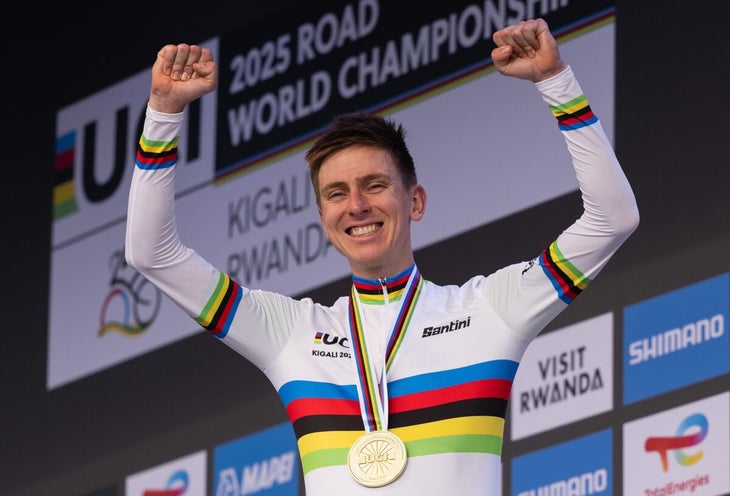 Another year, another huge solo, another rainbow jersey (Photo: David Ramos/Getty Images )
Another year, another huge solo, another rainbow jersey (Photo: David Ramos/Getty Images )
Next year’s road world championships take place in Montréal, on a course that will likely be similar to the one that Pogačar and Brandon McNulty dominated a few weeks ago. The 2027 road world championships in Sallanches look even harder, with a course that is rumoured to ascend the Côte de Domancy (2.6km at 8.6%) 20 times.
No one has ever won more than three consecutive road world Championships. Peter Sagan three-peated from 2015-2017.
With some of the hardest-ever worlds courses coming in the next two years, Pogačar could have his eyes set on another record-setting achievement.
***
Power Analysis data courtesy of Strava
Riders:
Tadej Pogačar
Remco Evenepoel
Isaac del Toro
Pavel Sivakov

